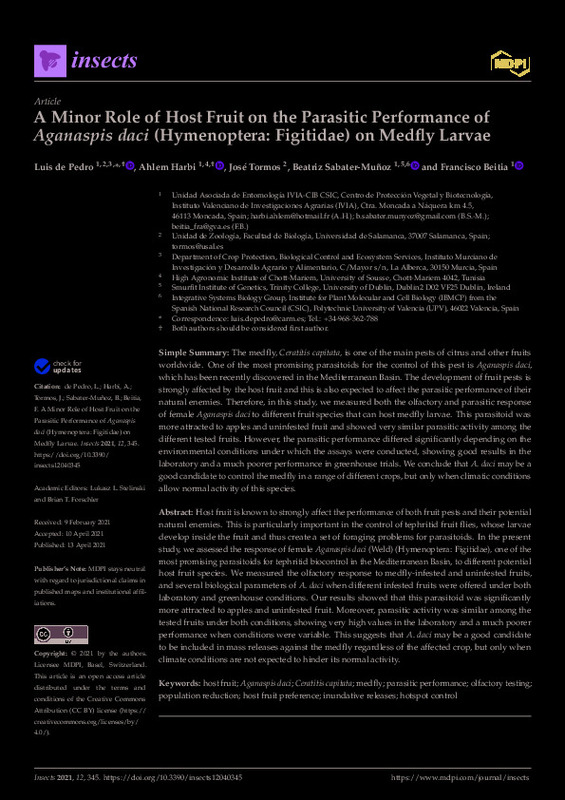|
Resumen:
|
[EN] The medfly, Ceratitis capitata, is one of the main pests of citrus and other fruits worldwide. One of the most promising parasitoids for the control of this pest is Aganaspis daci, which has been recently discovered ...[+]
[EN] The medfly, Ceratitis capitata, is one of the main pests of citrus and other fruits worldwide. One of the most promising parasitoids for the control of this pest is Aganaspis daci, which has been recently discovered in the Mediterranean Basin. The development of fruit pests is strongly affected by the host fruit and this is also expected to affect the parasitic performance of their natural enemies. Therefore, in this study, we measured both the olfactory and parasitic response of female Aganaspis daci to different fruit species that can host medfly larvae. This parasitoid was more attracted to apples and uninfested fruit and showed very similar parasitic activity among the different tested fruits. However, the parasitic performance differed significantly depending on the environmental conditions under which the assays were conducted, showing good results in the laboratory and a much poorer performance in greenhouse trials. We conclude that A. daci may be a good candidate to control the medfly in a range of different crops, but only when climatic conditions allow normal activity of this species.
Host fruit is known to strongly affect the performance of both fruit pests and their potential natural enemies. This is particularly important in the control of tephritid fruit flies, whose larvae develop inside the fruit and thus create a set of foraging problems for parasitoids. In the present study, we assessed the response of female Aganaspis daci (Weld) (Hymenoptera: Figitidae), one of the most promising parasitoids for tephritid biocontrol in the Mediterranean Basin, to different potential host fruit species. We measured the olfactory response to medfly-infested and uninfested fruits, and several biological parameters of A. daci when different infested fruits were offered under both laboratory and greenhouse conditions. Our results showed that this parasitoid was significantly more attracted to apples and uninfested fruit. Moreover, parasitic activity was similar among the tested fruits under both conditions, showing very high values in the laboratory and a much poorer performance when conditions were variable. This suggests that A. daci may be a good candidate to be included in mass releases against the medfly regardless of the affected crop, but only when climate conditions are not expected to hinder its normal activity.
[-]
|
|
Agradecimientos:
|
This research was funded by the Spanish Ministry of Science and Innovation (MICINN), grant number AGL2010-213-49-C02-02; the Spanish Ministry of Foreign affairs, the European Union and cooperation (AECID) grants A/01277/08 ...[+]
This research was funded by the Spanish Ministry of Science and Innovation (MICINN), grant number AGL2010-213-49-C02-02; the Spanish Ministry of Foreign affairs, the European Union and cooperation (AECID) grants A/01277/08 and A/024220/09; the Conselleria de Agricultura, Pesca y Alimentacion de la Generalitat Valenciana, with an institutional grant to the IVIA; and the Spanish and Tunisian Ministries of Education with the PhD fellowships to A.H. and L.d.P. (grant No. FPU-AP2010-2340).
[-]
|









